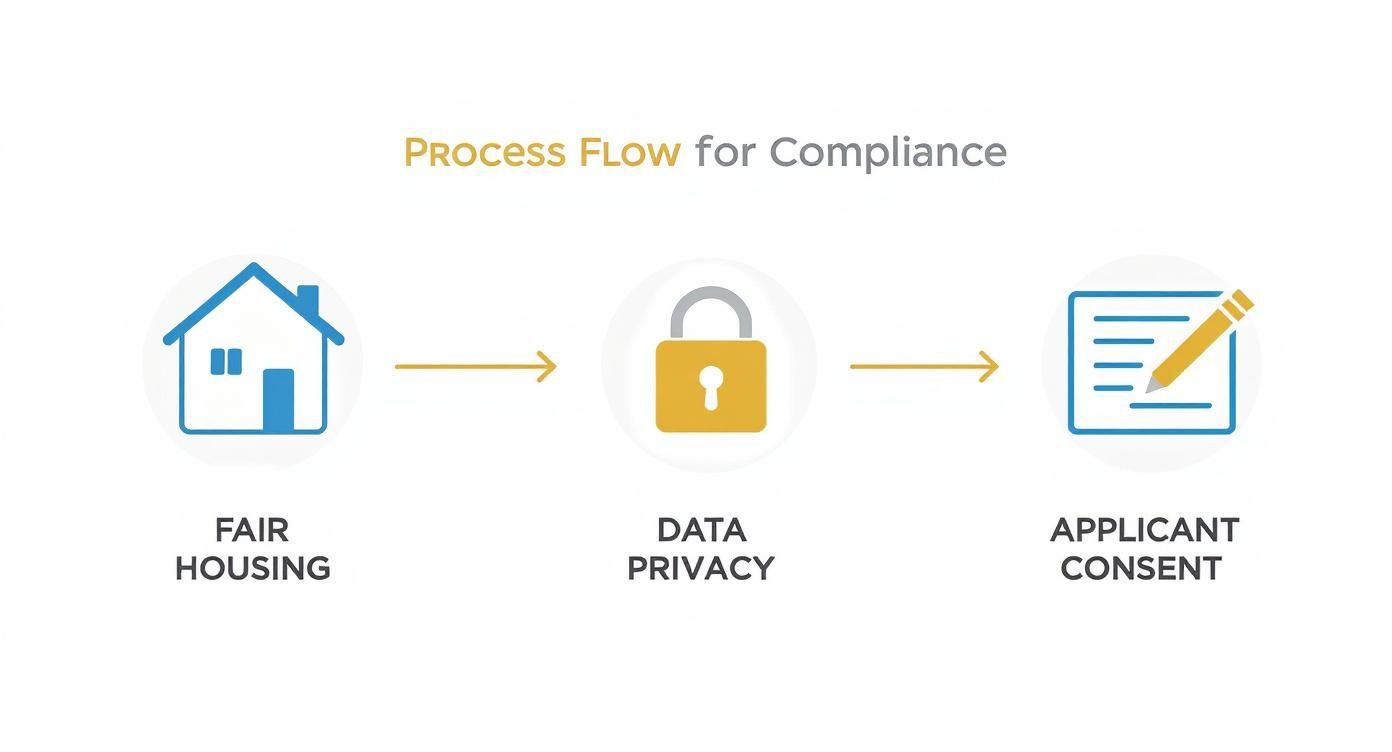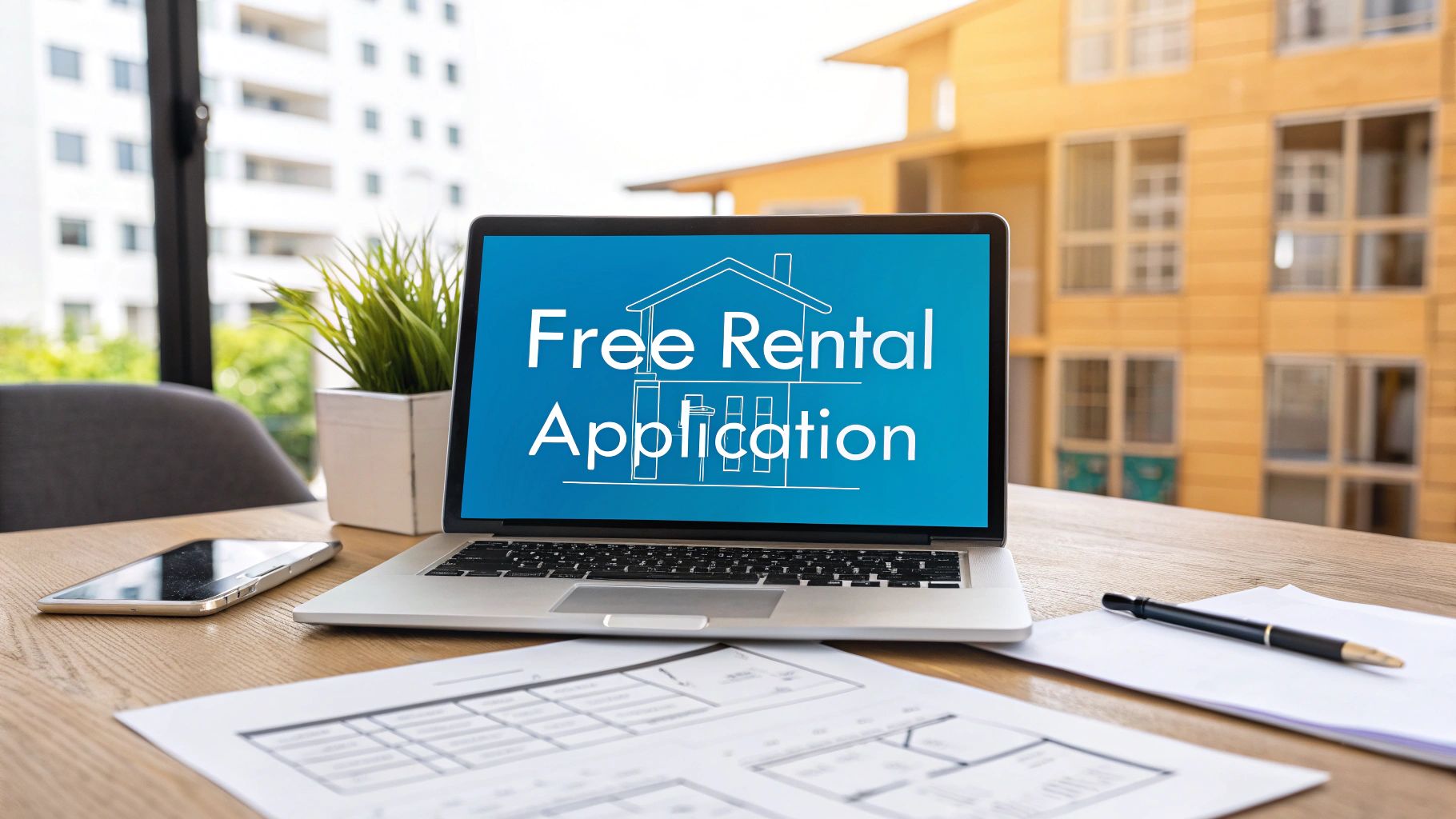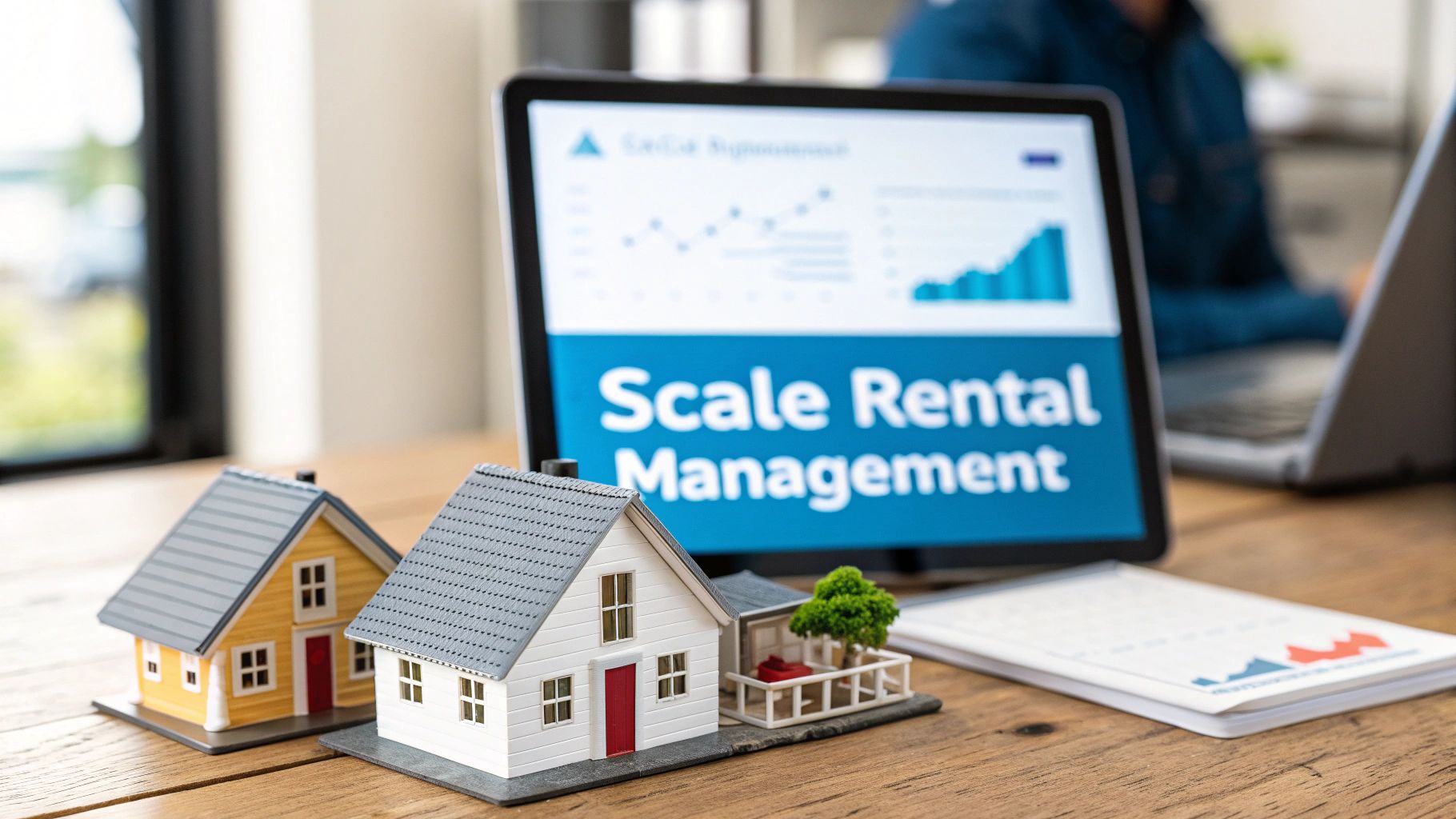For enterprise-scale property management companies, a free online rental application isn't a simple convenience—it’s a critical operational tool for reducing Days on Market (DOM) and protecting portfolio-wide revenue. When managing hundreds or thousands of units, every inefficiency in the leasing funnel translates directly to lost income.
Digitizing this first step is a strategic move to accelerate the entire lead-to-lease cycle. Moving away from manual, paper-based applications eliminates a significant bottleneck, directly impacting your cost per door and operational efficiency. For a large portfolio, this isn't just about modernizing; it's about capturing qualified leads faster than the competition and converting them before they move on.
Why Online Applications Are a Competitive Necessity at Scale

When you're managing a large, distributed portfolio, every point of friction has a quantifiable cost. The legacy paper application process—with its manual data entry, physical drop-offs, and slow processing times—is a massive operational drag that directly inflates Days on Market (DOM).
Every additional day a unit sits vacant erodes your net operating income (NOI). For a large portfolio, this isn't a minor leak; it's a significant financial drain that impacts profitability at scale.
By switching to a seamless online application, you instantly remove these roadblocks for highly motivated applicants. This allows a prospective tenant to apply on the spot, immediately after a showing, capturing their interest at its peak before they can explore other properties. This speed is paramount for optimizing your lead-to-tour conversion rates.
The Financial Impact of Speed and Accessibility
The primary benefit of an online application is its direct impact on your speed-to-lease. This isn't just about operational convenience; it’s about fine-tuning your leasing funnel to convert qualified leads into signed leases with maximum efficiency.
Here’s the ROI breakdown for enterprise portfolios:
- DOM Reduction: By eliminating processing delays, you can screen and approve applicants in a fraction of the time, shaving critical days off your vacancy period. For a 1,000-unit portfolio with an average rent of $1,800/month, reducing the average DOM by just two days adds $120,000 back to your annual revenue.
- Improved Lead Conversion: A frictionless, mobile-friendly application process meets the expectations of modern renters. A superior user experience leads to fewer abandoned applications, widening your pool of qualified candidates and improving your cost per acquisition.
The rental market's digital shift is accelerating. The online home rental market is projected to grow from USD 20.4 billion in 2025 to USD 82.5 billion by 2035, driven by renters who demand digital-first experiences. This data confirms that sophisticated digital tools are mandatory for running a scalable property management operation.
For enterprise-scale property managers, a free online rental application isn't a cost-saving measure. It’s a revenue-generating tool that directly improves core KPIs like DOM and lead conversion, providing a critical competitive advantage.
Integrating an online rental application is a foundational step in your operational digital transformation for small businesses and large enterprises alike. It standardizes a vital process across your entire portfolio, ensuring every applicant receives a consistent, professional experience, regardless of their location. This is a critical first step toward winning in a competitive, digital-first rental landscape.
Choosing the Right Platform for Your Portfolio

When managing a large portfolio, the term "free" must be evaluated through an operational lens. While a generic form builder has no upfront cost, it can introduce significant compliance risks and process inefficiencies that ultimately cost your portfolio far more in liability and lost revenue.
Choosing the right free online rental application means looking beyond the price tag to evaluate features that support scalability and mitigate risk.
Generic Form Builders vs. Property Management Software
The market for free tools is divided into two categories, each with massive implications for a large-scale operation.
On one side are generic builders like Google Forms. They are easy to use but were not designed for the complexities of property management. They lack the necessary security protocols for handling sensitive applicant data (personally identifiable information) and offer no built-in safeguards for Fair Housing compliance, creating significant risk at scale.
On the other side are freemium property management platforms such as Zillow Rental Manager or Avail. These are purpose-built for the rental industry. Their free offerings typically include a compliant, secure application process designed to serve as an on-ramp to their paid services, like tenant screening or rent collection.
The difference for an enterprise operation is stark. A dedicated platform centralizes applications, listings, and communications, providing a unified system of record that is essential for remote management.
Key Evaluation Criteria for Enterprise Portfolios
When vetting a new platform, your operations team needs a robust evaluation framework. A tool must do more than just collect information; it must integrate seamlessly into your tech stack and strengthen your leasing workflow.
Here’s the enterprise checklist:
- Integration Capabilities: Does the platform offer a robust API or pre-built integrations with your core property management systems, like AppFolio or RentManager? Manual data entry is a non-starter at scale; it’s slow, error-prone, and kills your speed-to-lease.
- Compliance Guardrails: An enterprise-grade platform must have default settings and question templates aligned with FHA guidelines. This is crucial for standardizing processes across multi-market portfolios and preventing accidental non-compliance by remote teams.
- Data Security Protocols: You must verify that the platform uses SSL encryption and secure data storage. You are handling applicants' most sensitive information, and enterprise-grade security is non-negotiable for maintaining trust and complying with data privacy laws.
The table below breaks down how these tool types measure up against the features that matter most for a large property management company.
Feature Comparison of Free Online Application Tools
While generic form builders are technically "free," they lack the foundational features required for a professional, compliant, and scalable leasing operation. Freemium PM software is a significant improvement, but dedicated leasing automation tools often provide the deepest integration and workflow efficiencies.
For a portfolio of 1,000+ units, the application tool isn't just a form—it's a critical piece of your technology infrastructure. Its ability to integrate and scale securely is far more valuable than its initial cost.
Ultimately, your goal is to select a platform that enhances team efficiency without creating new operational risks. You can explore a detailed comparison of Showdigs vs other leasing software to see how dedicated leasing automation platforms stack up against broader property management systems.
Designing an Application That Converts Top Applicants at Scale
Your online application is one of the most critical conversion points in your entire leasing funnel. A poorly designed form—one that is clunky, confusing, or excessively long—directly increases applicant drop-off rates. This inflates your cost per lead and extends your Days on Market (DOM), negatively impacting revenue across your portfolio.
Creating a high-converting free online rental application requires balancing comprehensive data collection with a frictionless user experience. The objective is to design an efficient, professional process that benefits both the applicant and your leasing team.
Core Sections of a High-Conversion Application
To build a form that performs, focus on clarity and logical flow. Group related fields into distinct sections to guide the applicant through the process seamlessly.
These sections are non-negotiable for any enterprise operation:
- Personal Information: Collect the full legal name, date of birth, phone number, and email for every adult who will reside in the unit.
- Residential History: Require at least the last two to three years of addresses, including landlord contact information and the reason for leaving each property. This provides the necessary data for rental verifications.
- Employment and Income: Obtain details on the current employer, job title, and supervisor's contact information, along with verifiable gross monthly income. A key feature is the ability for applicants to upload supporting documents—such as pay stubs or offer letters—directly within the form.
This structured approach not only simplifies the process for applicants but also accelerates the review process for your team. Clean, organized data allows leasing agents to quickly identify qualified candidates and advance them to the next stage.
Streamlining the Applicant Experience
The key to maintaining applicant engagement is to build a "smart" form. Modern application platforms use conditional logic to show or hide questions based on previous answers, creating a tailored experience.
For example, if an applicant indicates they have a pet, a new section can dynamically appear to collect the pet's breed, size, and vaccination details. This keeps the form concise and relevant for all users, reducing friction and abandonment.
An optimized application form has a direct impact on your bottom line. Reducing applicant drop-off widens your pool of qualified candidates, providing the leverage needed to fill vacancies faster and minimize revenue loss from high DOM.
The rental market has evolved, with a notable shift toward single-family rentals. This trend has spurred technological advancements, including integrated applications, screening, and digital leasing tools that are essential for maximizing revenue. For further analysis on this trend, see recent market reports from sources like Baselane.
A well-designed application signals operational excellence. For more on turning prospects into tenants, explore these essential conversion rate optimization tips. Optimizing this single touchpoint can significantly improve overall leasing performance and is a key factor in achieving industry-leading conversion rates.
Staying Compliant and Secure When You’re Managing Hundreds of Units
As your portfolio scales, compliance and data security transition from a checklist item to the foundation of your operations. A single misstep with a free online rental application can expose your company to significant legal and financial risk. Mitigating this risk requires a standardized, defensible process across every unit you manage.
Every question on your application must be scrutinized for Fair Housing Act (FHA) compliance. An seemingly innocuous question can be interpreted as discriminatory, creating substantial liability. This is a primary failing of generic form builders for professional property managers—they lack the built-in guardrails to prevent staff from inadvertently asking about protected classes like religion or familial status.
Handling Data Privacy and Earning Applicant Trust
Beyond Fair Housing, you are the custodian of an immense amount of sensitive data, including Social Security Numbers and financial details. Applicants entrust you with their personal information, and a growing number of state privacy laws hold you directly accountable for its protection.
This makes choosing a platform with enterprise-grade security non-negotiable. Key security features must include:
- SSL Encryption: This is the baseline standard, ensuring data transmitted from the applicant's device to your system is secure from interception.
- Secure Data Storage: The platform must store applicant data in a protected environment with strict access controls.
- Clear Data Policies: You must be able to easily access and understand the service's policies on data handling, storage, and disposal.
For a property manager at scale, the potential cost of one data breach or a fair housing lawsuit is infinitely higher than any savings from a free, non-compliant tool. Thinking about security and legal compliance isn't just an IT problem; it's a core business strategy.
Building a Rock-Solid Consent Framework
The final component of a compliant process is obtaining clear, documented consent from every applicant. This cannot be buried in fine print. Your online application must feature a dedicated disclosure and authorization section that applicants must actively agree to before submission.
This section must explicitly state how their information will be used. A comprehensive consent framework should include:
- Authorization for Tenant Screening: Clearly state that you will be conducting background and credit checks as part of the evaluation process.
- Verification Consent: Obtain explicit permission to contact previous landlords and current employers to verify the information provided.
- Data Privacy Acknowledgment: Require applicants to confirm they have reviewed and understand your company's privacy policy.
By building these consent mechanisms directly into your application, you create a consistent and defensible process across your entire portfolio. This not only mitigates risk but also signals to high-quality applicants that you are a professional organization that takes their responsibilities—and their privacy—seriously.
Integrating Your Application into the Leasing Funnel
A free online rental application only becomes a true operational asset when it is deeply integrated into your leasing workflow. Otherwise, it's merely a digital form, not a tool that drives efficiency. To meaningfully reduce Days on Market (DOM) and increase team productivity, the application must function as the engine of your entire lead-to-lease process.
This begins with discoverability. An interested prospect should never have to hunt for the "Apply Now" button. It must be prominently displayed on your property listings, your company website, and linked in your social media posts. Critically, it should also be included in all automated communications, such as email and text follow-ups after a tour is scheduled or completed.
Automating the Post-Application Workflow
The real operational gains occur the moment an applicant clicks "submit." For any property manager overseeing a large portfolio, manual hand-offs of applications are a major bottleneck. Automation is not a luxury; it's a necessity for scalability.
Your system should trigger several key actions automatically:
- Instant Team Notifications: The moment an application is received, a notification should be sent to the appropriate leasing agent's inbox, Slack channel, or directly within your property management software. This eliminates lag time and allows your team to begin screening while the lead is still highly engaged.
- Automated Applicant Confirmations: Simultaneously, the applicant should receive an automated email or text confirming receipt of their application. This small touch manages expectations and reinforces a professional, responsive image.
Powering Your Tech Stack with Application Data
For tech-forward property management companies, the application is more than a form—it's a critical data source. Manually transcribing applicant information from a PDF into your Property Management Software (PMS) or CRM is an inefficient, error-prone task that does not scale.
The objective is to create a seamless flow of information from the initial application to the signed lease without manual data entry. This not only mitigates the risk of human error but also shaves critical hours off the leasing timeline for every single unit.
This infographic provides a high-level overview of maintaining a compliant and secure workflow when integrating these tools.

The key takeaway is that all automation must be built on a foundation of robust compliance and security to protect both your business and your applicants.
Modern platforms achieve this integration through APIs, webhooks, or tools like Zapier, which can pipe application data directly into your other systems. Investing time in exploring these deep PMS and CRM integrations is how you build a leasing funnel that truly operates at scale. This data also provides insights into renter behavior. For example, recent reports show on-time rent payments reached 85.7% in early 2025, a trend partially supported by digital tools that streamline the rental process. You can read the full rental performance report for more industry trends. By connecting your systems, you transform a simple form submission into the catalyst for a faster, more efficient leasing operation.
Answering Your Top Questions
Implementing a new system across a large portfolio inevitably raises questions. A free online rental application is a powerful tool, but its effectiveness depends on proper implementation regarding security, customization, and legal compliance. Let’s address the most common concerns for enterprise property managers.
Is a Free Online Application Secure Enough for Sensitive Data?
This is the most critical question, and the answer depends entirely on the platform you choose. Security must be your primary evaluation criterion.
Generic form builders are not designed for the Personally Identifiable Information (PII) required in a rental application. They typically lack the specific security protocols needed to protect Social Security numbers and financial data, creating unacceptable risk at scale.
Conversely, a reputable freemium property management software is purpose-built for this function. Look for platforms that explicitly state they use SSL encryption and have transparent, secure data storage policies. Your operations team must conduct due diligence on their security certifications and data handling protocols before adoption.
Can I Customize a Free Application for My Company’s Needs?
Customization capabilities vary widely among free tools. Most will allow basic modifications, such as adding, removing, or reordering standard questions to align with your screening criteria.
However, advanced features essential for a sophisticated applicant experience, such as conditional logic (displaying questions based on previous answers) or full white-label branding, are often premium features.
Before evaluating platforms, map out your "must-have" application fields and features. This will prevent you from selecting a tool that cannot meet your operational needs as you scale.
For multi-market portfolios, the ideal tool allows for customization based on local regulations while maintaining a standardized core application. This is key to ensuring both compliance and operational consistency across all properties.
How Do I Make Sure My Online Application Follows Fair Housing Laws?
Compliance hinges on the questions you ask—and, more importantly, those you don’t. The most effective way to mitigate risk is to avoid any questions related to protected classes under the Fair Housing Act. This includes inquiries about race, religion, familial status, disability, or national origin.
This is where a dedicated property management platform provides immense value. They often come with pre-built, legally vetted application templates that include compliance guardrails, preventing your team from inadvertently adding a non-compliant question.
Beyond the form itself, the most critical aspect of compliance is ensuring your screening criteria are applied consistently and equitably to every applicant without exception. This standardized process is your most robust defense against potential fair housing claims.
Ready to accelerate your entire leasing process, from lead to lease? Showdigs combines intelligent automation with a network of on-demand, licensed agents to reduce your Days on Market and improve lead-to-tour conversion rates. Discover how to streamline your operations at scale by visiting https://showdigs.com.






